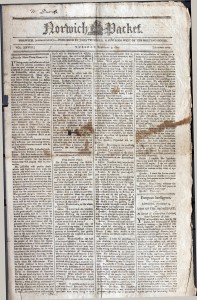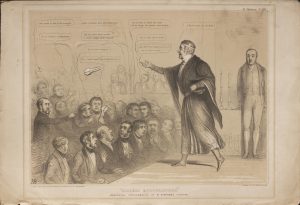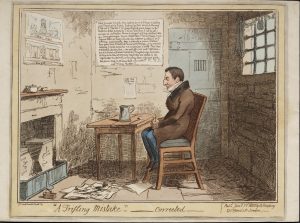The Election of 1800
[Posted by Len Banco for AMST 838: America Collects Itself: From Colony to Empire]
 The election of 1800 was pivotal in American history, ultimately resulting in the first democratic peaceful transfer of power between two opposing political groups – the Federalists of John Adams who was the sitting President, and the Republicans of Thomas Jefferson, who was the sitting Vice President. What I searched for and found at the Watkinson were two issues of a 4-page Connecticut newspaper, the Norwich Packet, published on February 24 and March 3, 1801. My purpose in finding those newspapers was to understand what an ordinary American citizen of the time would be reading about the election and its immediate aftermath. We began our search the old-fashioned way, using a card catalog, and after a bit of hunting, found a cache of original newspapers unbound as readers over 200 years ago would have read them. I wondered if anyone back then could have possibly anticipated that a newspaper they used one day and threw out the next would survive for so long.
The election of 1800 was pivotal in American history, ultimately resulting in the first democratic peaceful transfer of power between two opposing political groups – the Federalists of John Adams who was the sitting President, and the Republicans of Thomas Jefferson, who was the sitting Vice President. What I searched for and found at the Watkinson were two issues of a 4-page Connecticut newspaper, the Norwich Packet, published on February 24 and March 3, 1801. My purpose in finding those newspapers was to understand what an ordinary American citizen of the time would be reading about the election and its immediate aftermath. We began our search the old-fashioned way, using a card catalog, and after a bit of hunting, found a cache of original newspapers unbound as readers over 200 years ago would have read them. I wondered if anyone back then could have possibly anticipated that a newspaper they used one day and threw out the next would survive for so long.
In a section headed simply, “Election of a President” the results of the election of 1800 (as reprinted from the Philadelphia Gazette of February 14) were officially recounted thus – “According to the rules of the proceeding established by the House, they proceeded to the Senate chamber where….the votes were counted and the result declared by the Vice President [Thomas Jefferson] as follows: Thomas Jefferson 73, Aaron Burr 73, John Adams 65, C.C. Pinckney 64, John Jay 1”. The tie vote between Jefferson and Burr required the House of Representatives to determine the winner through a process prescribed by the constitution, with each state having one vote and it being necessary to have a simple majority of the states to win.
In that same issue, the repeated indecisive votes in the House of Representatives were relayed – “Eight states for Jefferson, Six for Burr, 2 divided” along with a description of the actual method of balloting. One of the representatives from Maryland was so ill he was unable to go to the House chamber, “and had a bed prepared for him in one of the committee rooms to which the ballot box was carried to him by one of the tellers appointed on the part of the state”. The deadlock continued for days.
In the issue of March 3 it was related that on the 35th ballot taken on Tuesday, February 17, the deadlock was finally broken, resulting in the election of Thomas Jefferson as president with 10 states for him, only 4 New England States for Aaron Burr, and two states with blank ballots.
In a small “Public Notice” on the third page of the paper there appeared a notice that “A Day of Thanksgiving is to be kept in Wallingford on the 11th day of March next”…and “at 6 in the evening on the same day an oration will be delivered by Abraham Bishop esq, of New Haven” . “All real friends to our happy constitution and to our illustrious Thomas Jefferson, President-elect, and to Aaron Burr, our patriotic and worthy Vice-President, elect, are invited to attend”. Interestingly, the transcript of Mr. Bishop’s remarks was subsequently published in New Haven that same year, an original copy of which also resides at the Watkinson Library.
This is what a citizen of Norwich, Connecticut would have read in 1801, two weeks after the actual event. They would not have known yet how or why the change in vote occurred that ultimately resulted in Jefferson’s election. The political intrigue and bargaining that resulted in the final outcome has taken over 200 to understand and ponder and the debate continues to this day.


